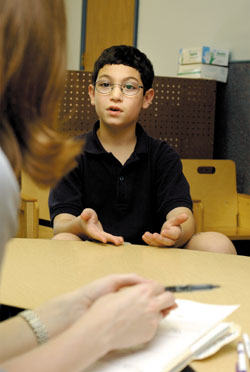
Adam Caplan is one of the clients enrolled in the Bill Wilkerson Center’s program for stuttering. (photo by Dana Johnson)
Families may help stuttering children
Everyone in the world is affected by speech. We learn to communicate by using words at a very early age. Often times, though, a child’s speech can be halted by stuttering.
Approximately one percent of children stutter and it can become very worrisome for both the child and the parent. The causes of stuttering are not known, but knowledge is increasing. It is now known that many children who stutter may have co-occurring speech and language problems. However, there is hope.
A program at the Vanderbilt Bill Wilkerson Center is focusing on the parents’ role in helping a child who stutters.
“Stuttering typically involves repetitions or prolongation of sounds and syllables,” said Dr. Edward G. Conture, professor of Hearing and Speech Sciences.
Even though there is no evidence to indicate that parents cause stuttering, there are many things that parents can do to help their child.
“It is a unique way of working with this problem,” said Conture. “Parents provide the communicative sea in which a child swims. If the waters are turbulent, it is hard to succeed. It is a behavioral change that parents learn in attempts to help their child become more fluent.”
Since stuttering is an issue for both the child and the parent, speech-language pathologists now typically recommend parents come into therapy with their children to work both ends toward the middle, Conture said.
“We bring the parents and the child in together weekly in what we call parent-child groups,” said Conture. “We are now to the point that we routinely ask for parents to come in with their children once we have evaluated their child.”
Parent-child therapy groups are now the state-of-the-art approach with childhood stuttering. Due to the developmental differences among children, treatment groups are organized according to age.
Therapy for a child can usually take anywhere from six to 24 months, depending on the age of the child, the nature/severity of the child’s stuttering and family involvement.
Children often feel that they are the only ones who stutter. Adam Caplan, 9, began stuttering around age three.
“In therapy, I feel safer,” Adam said, “because I am with other people with the same problem.”
“Being with other kids who share the same kind of problems and also sit in the room with other parents and to hear about their frustrations is the comfort level of knowing that you are really not in this alone,” said Donna Caplan, Adam’s mother. “We all have a common problem.”
“I am convinced that over time that our treatment of stuttering is going to very much involve not only just the stuttering or the repetitions, but for some kids, other facets of their speech and language as well,” said Conture.
“Stuttering is a very fixable problem,” Adam said. “I am here to say that there is hope because I overcame my speech problem.”
Conture has written a book, “Stuttering: Its Nature, Diagnosis and Treatment,” that deals with the theoretical and evidential base for this particular approach to stuttering. For more information on childhood stuttering, contact the Bill Wilkerson Center at 936-5000 or the Stuttering Foundation of America at www.stutteringhelp.org.













